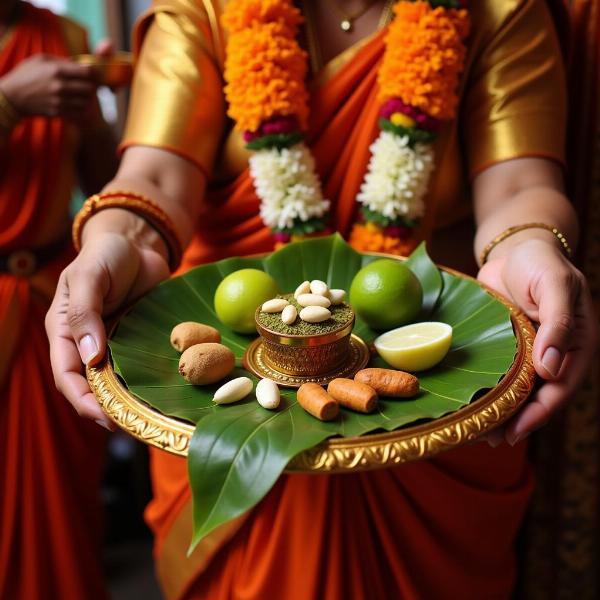Tambul, a word deeply rooted in Indian tradition, holds a significance that extends far beyond its literal meaning. While it translates simply to “betel leaf,” tambula encompasses a rich cultural practice with deep historical and social implications. This article will explore the various facets of tambula, from its components and preparation to its significance in religious ceremonies, social gatherings, and Ayurvedic medicine.
Understanding the Significance of Tambul in Indian Culture
Tambul isn’t merely a combination of betel leaf and other ingredients; it represents a symbol of hospitality, respect, and auspicious beginnings. Offering tambula to guests is a common practice in many Indian households, signifying warmth and goodwill. Its presence in religious ceremonies further highlights its sacred nature, representing purity and divine blessings.  Tambul Offering Ceremony
Tambul Offering Ceremony
Decoding the Ingredients of Tambul
The traditional tambula consists of a betel leaf (paan) filled with a mixture of areca nut (supari), slaked lime (chuna), and often catechu (katha). These core ingredients are often complemented by various spices and sweeteners, such as cardamom, cloves, nutmeg, and gulkand (rose petal preserve), to enhance the flavor and aroma. The specific combination of ingredients can vary regionally and according to personal preferences.
Tambul in Religious Ceremonies and Rituals
Tambul plays a prominent role in Hindu religious rituals, especially weddings and pujas (prayer ceremonies). It is offered to deities as a mark of reverence and is also distributed among devotees as prasad (blessed offering). The offering of tambula is believed to bring good fortune and blessings.
The Social Etiquette of Offering and Receiving Tambul
Offering and receiving tambula is a nuanced social practice governed by specific etiquette. The manner in which tambula is presented and accepted reflects respect and courtesy. Generally, it is offered with the right hand and received with the right hand, symbolizing honor and appreciation.
Tambul and Ayurveda: Exploring the Medicinal Benefits
Beyond its cultural and religious significance, tambula also holds a place in Ayurvedic medicine. It is believed to aid digestion, freshen breath, and have astringent properties. However, excessive consumption can have adverse effects, highlighting the importance of moderation.
Regional Variations in Tambul Preparations
Across India, diverse regional variations of tambula exist, reflecting the unique culinary traditions of each area. From the sweet and minty paan of the north to the more complex and spicy preparations of the south, each variation offers a distinct sensory experience.
Is Tambul Addictive? Addressing Common Concerns
The areca nut in tambula contains alkaloids that can be mildly stimulating and, with excessive use, potentially addictive. It’s important to be mindful of consumption and avoid overindulgence.
Conclusion: The Enduring Legacy of Tambul
Tambul, with its multifaceted significance, continues to hold a special place in Indian culture. From religious ceremonies to social interactions and Ayurvedic practices, tambula represents a tradition that has stood the test of time. Understanding its cultural context and appreciating its nuanced meaning allows us to fully grasp the depth and richness of this ancient practice.
FAQ:
- What is the meaning of tambula in different Indian languages? While the core meaning remains similar, the specific term used for tambula varies across different Indian languages. For example, it’s known as “paan” in Hindi and several other North Indian languages.
- Is it compulsory to offer tambula to guests in Indian homes? While it’s a common tradition, it’s not strictly compulsory. However, offering tambula is generally considered a gesture of hospitality and respect.
- Are there any health risks associated with consuming tambula? Excessive consumption of areca nut, a key ingredient in tambula, can pose certain health risks, including oral cancer. Moderation is key.
- What is the significance of offering tambula to deities? Offering tambula to deities is a symbol of reverence and devotion, seeking blessings and good fortune.
- Can tambula be consumed at any time of the day? While there are no strict rules, tambula is typically consumed after meals as a digestive aid and breath freshener.
- Why is lime used in tambula? Lime helps release the alkaloids in the areca nut, enhancing its flavor and stimulating effect.
- Are there any non-tobacco versions of tambula? Yes, many tambula preparations do not include tobacco.
Meaning-Hindi.in specializes in providing high-quality Hindi translation services catering to various needs, including business, legal, technical, website localization, and educational document translation. We offer accurate, culturally sensitive, and timely translations, ensuring your message resonates effectively with your target audience. Contact us today for your Hindi translation needs! Email: [email protected], Phone: +91 11-4502-7584. For more information, visit Meaning-Hindi.in.